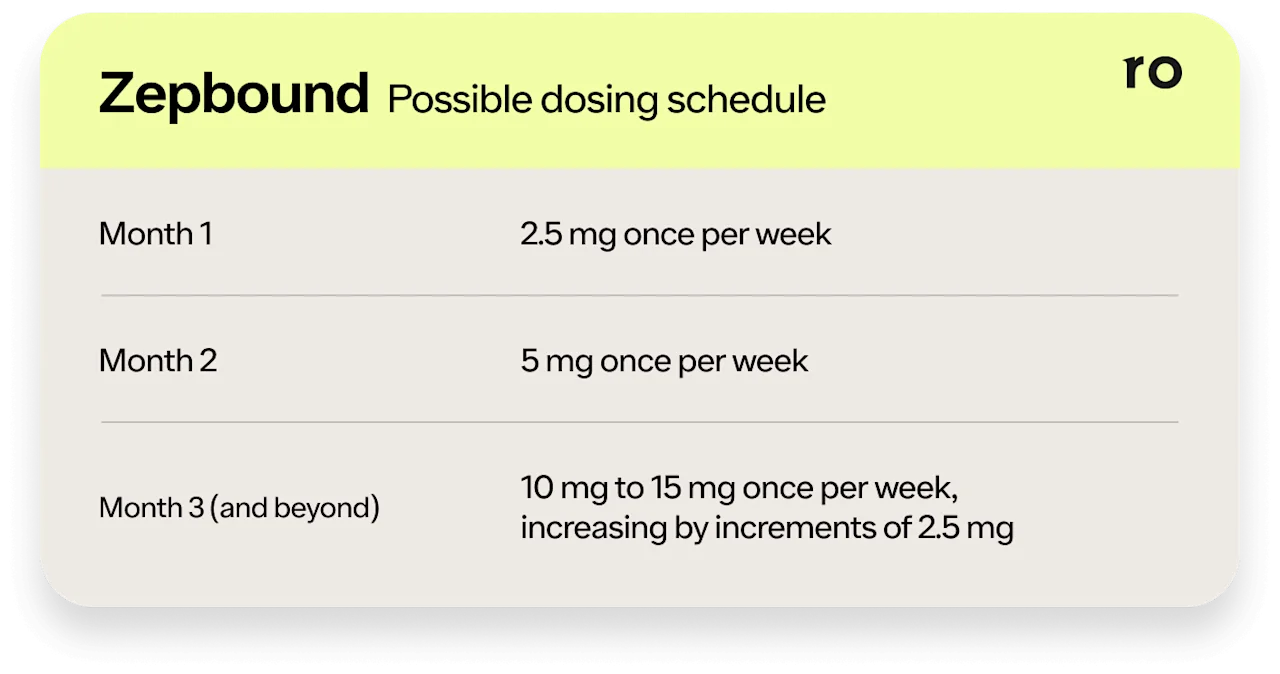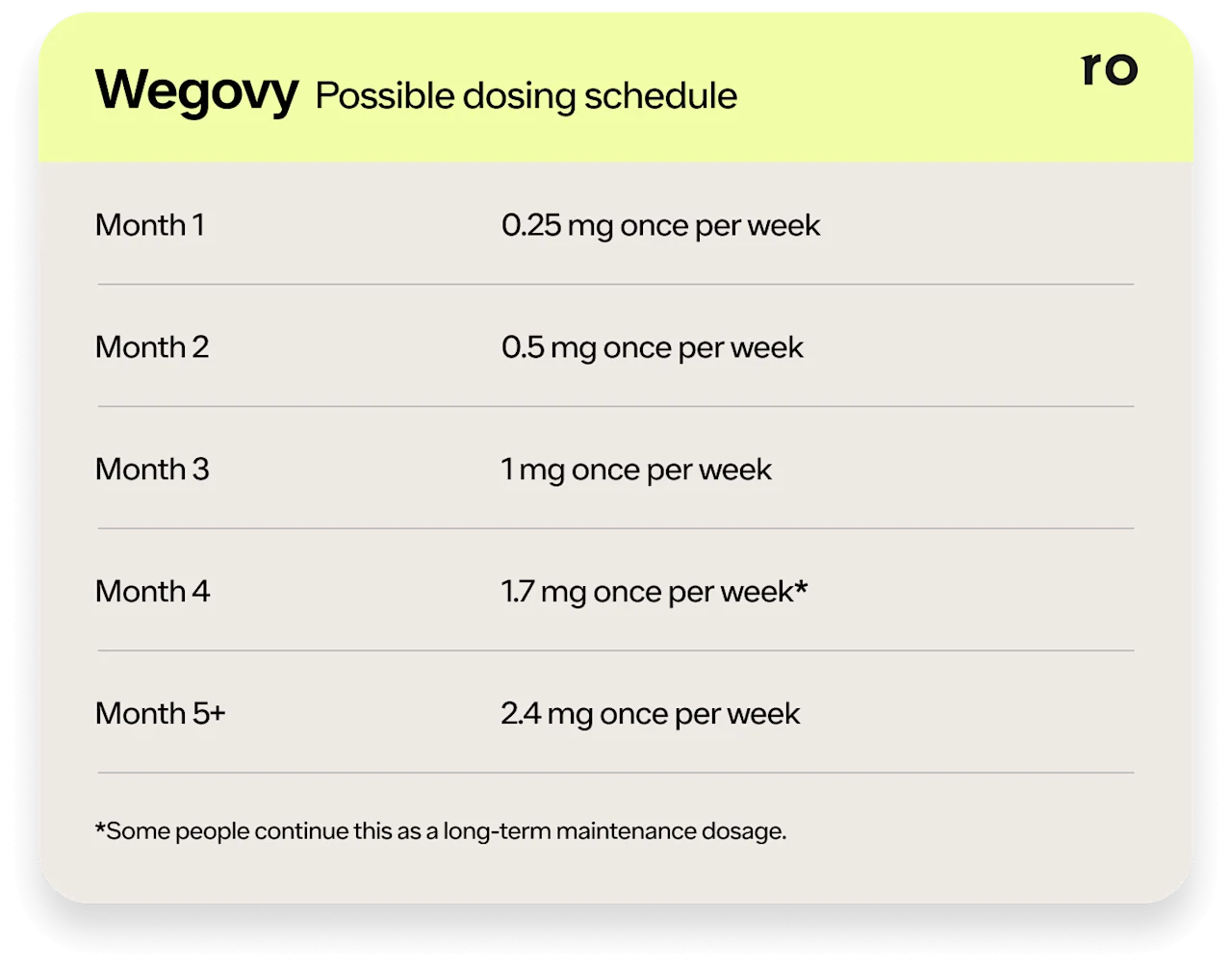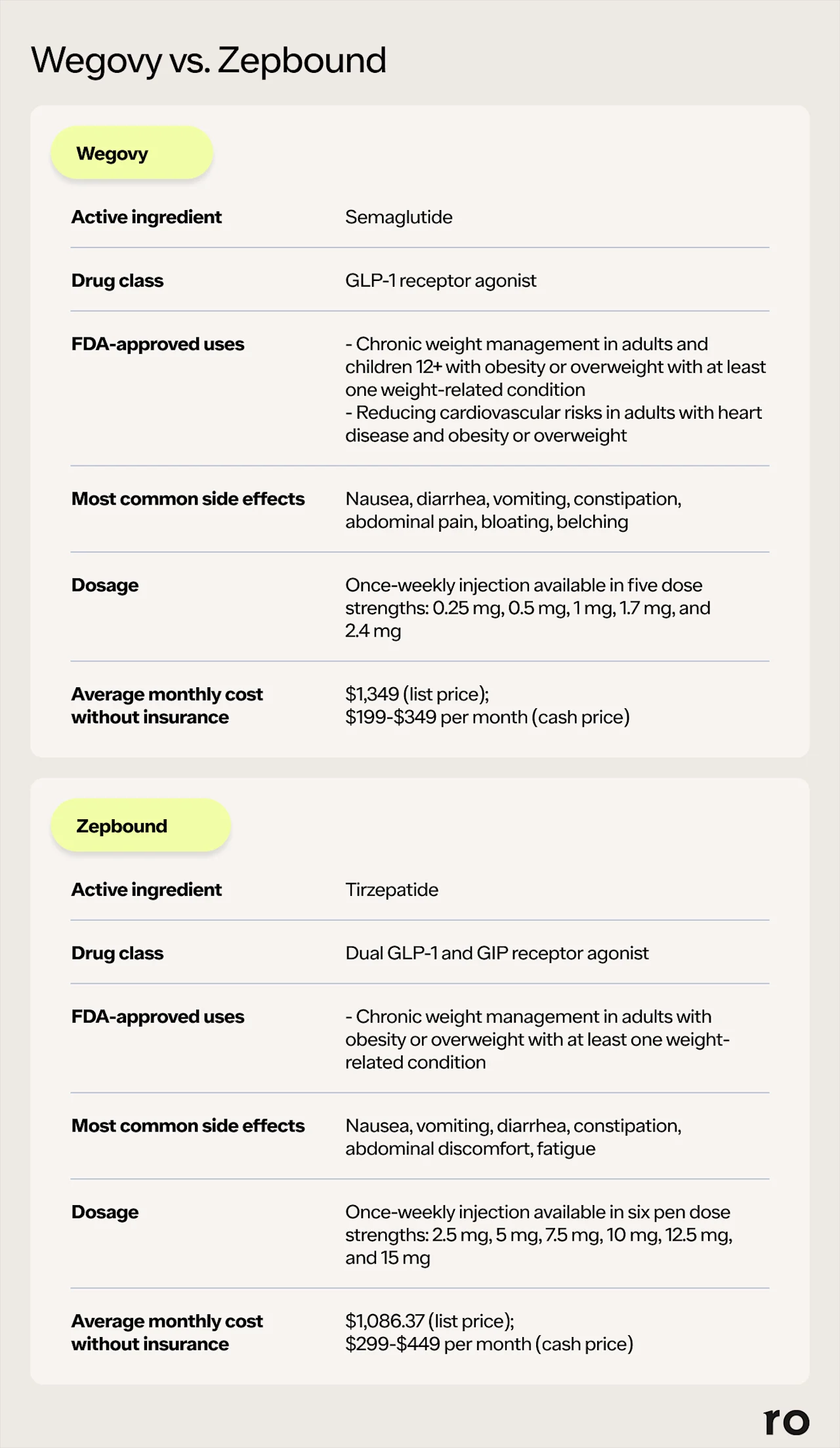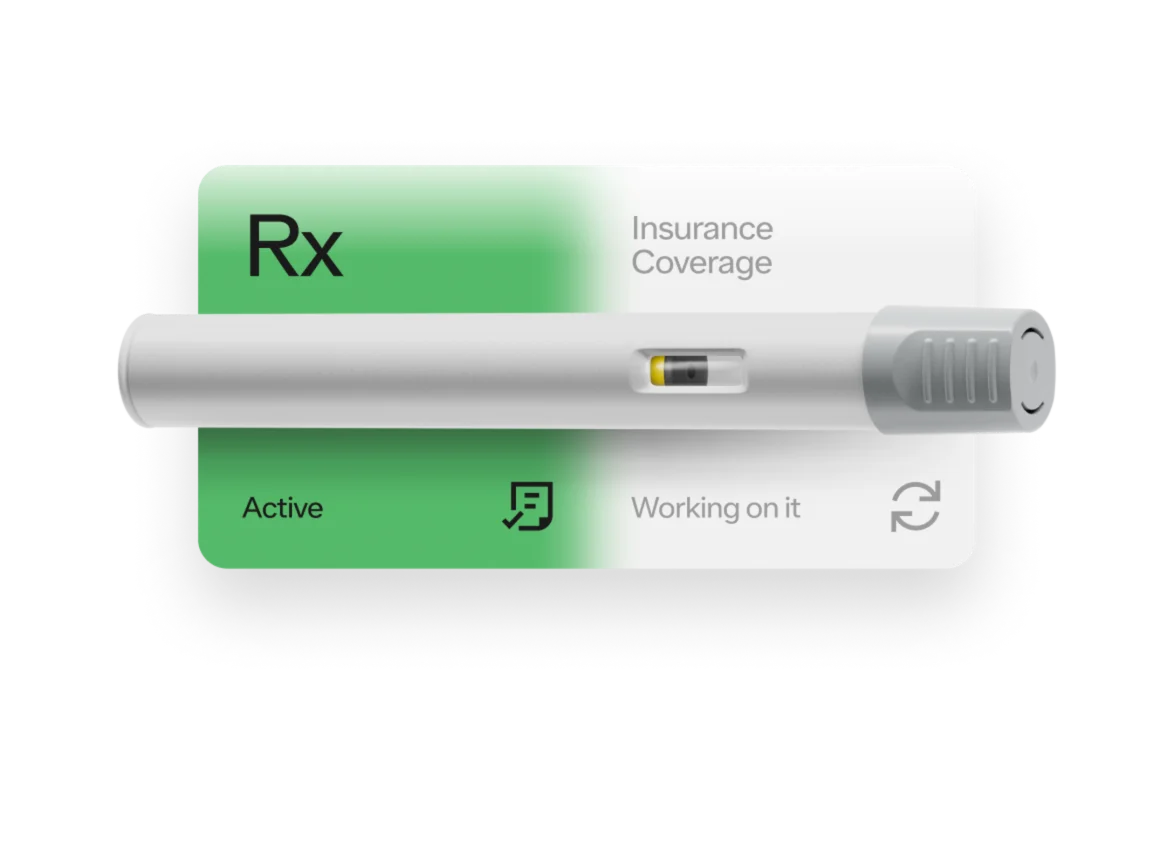Key takeaways
Zepbound and Wegovy are effective weight-loss medications with FDA approval for chronic weight management in adults with obesity or overweight and at least one weight-related health condition.
Clinical trials suggest that Zepbound (tirzepatide) leads to more significant weight reductions than Wegovy (semaglutide), likely due to its dual-action mechanism.
Side effects are similar for both medications and include nausea, diarrhea, and vomiting, with gastrointestinal issues being dose-dependent and typically mild to moderate.
Cost varies based on insurance and savings programs. Without insurance, monthly costs for both medications exceed $1,000, but cash-pay options and manufacturer savings programs can significantly lower out-of-pocket expenses for those who meet eligibility requirements.
Here's what we'll cover
Key takeaways
Zepbound and Wegovy are effective weight-loss medications with FDA approval for chronic weight management in adults with obesity or overweight and at least one weight-related health condition.
Clinical trials suggest that Zepbound (tirzepatide) leads to more significant weight reductions than Wegovy (semaglutide), likely due to its dual-action mechanism.
Side effects are similar for both medications and include nausea, diarrhea, and vomiting, with gastrointestinal issues being dose-dependent and typically mild to moderate.
Cost varies based on insurance and savings programs. Without insurance, monthly costs for both medications exceed $1,000, but cash-pay options and manufacturer savings programs can significantly lower out-of-pocket expenses for those who meet eligibility requirements.
If you’ve been trying to lose weight, you’ve probably heard these two names: Zepbound and Wegovy. These and other weight loss medications are transforming how many approach weight management, but when it comes to Zepbound vs. Wegovy, how do they stack up?
While studies have shown that both can aid in weight loss, there are subtle differences in how they work, dosing, and who they are suitable for.
Read on to learn everything you need to know about Zepbound and Wegovy, from how they work to their side effects, dosing schedules, how much they cost, and who might benefit most. By the end, you should feel confident talking to your provider about which medication might fit your weight loss journey.
What is Zepbound?
Zepbound (tirzepatide) is a prescription medication FDA-approved for chronic weight management in adults with overweight or obesity who have one or more weight-related health conditions, such as type 2 diabetes, high blood pressure, or high cholesterol.
This once-weekly injectable works as a dual-acting glucose-dependent insulinotropic polypeptide (GIP) and glucagon-like peptide-1 (GLP-1) receptor agonist. It supports weight loss by slowing digestion, regulating blood sugar levels, and promoting fat metabolism.
In clinical trials, people taking Zepbound lost 15% to 21% of their initial body weight within a year and a half — between 35 and 52 pounds on average. Long-term Zepbound use helps maintain weight loss and can lead to even greater weight loss.
In a separate study, participants who used Zepbound for up to 88 weeks lost an average of 25% of their starting body weight. Those who switched over to placebo experienced significant weight regain.
Combined with regular exercise and a reduced-calorie diet, Zepbound can promote weight loss and lowers the risk of obesity-related health problems, such as cardiovascular disease and diabetes.
Tirzepatide, the active ingredient in Zepbound, is also available as Mounjaro, which is FDA-approved for managing type 2 diabetes.
How does Zepbound work?
What sets Zepbound apart from other weight loss medications is its dual-action mechanism. It mimics two gut hormones:
Glucose-dependent insulinotropic polypeptide (GIP)
Glucagon-like peptide-1 (GLP-1).
The gut releases GIP and GLP-1 hormones in response to food intake.
Zepbound mimics and amplifies their effects by binding to and activating the GIP and GLP-1 receptors, enhancing the processes these hormones regulate, including slowed digestion, blood sugar regulation, and metabolism. While GIP receptor activation may enhance the effects of GLP-1 receptor agonism, its specific contribution to weight loss is not fully understood.
Here’s how this dual action makes Zepbound effective in promoting sustained weight loss:
Slows stomach emptying: Zepbound slows gastric emptying, keeping food in the stomach longer, promoting prolonged feelings of fullness, and reducing rapid spikes in blood sugar after meals. By helping you feel full longer after you eat, this delayed digestion can make maintaining a calorie deficit for weight loss easier.
Promotes fat metabolism: Scientists theorize that Zepbound’s dual-action mechanism can help the body break down fat in the liver more efficiently. Instead of relying mainly on sugars or carbs for energy, Zepbound can make it easier for your body to tap into fat stores for energy, helping increase fat burning and reducing body fat.
Regulates hunger signals: Animal research suggests that Zepbound may help balance hormones like ghrelin and leptin. Ghrelin, aka the “hunger hormone,” can make you feel hungry and promote overeating. By balancing ghrelin levels, Zepbound supports metabolic health and regulates appetite, leading to less food intake, which can help you stay within a calorie deficit.
Regulates blood sugar (glucose): Zepbound improves how the body uses insulin, a hormone that helps move sugar from the blood into cells for energy. By improving insulin sensitivity and stabilizing blood sugar levels, Zepbound reduces the likelihood of excess sugar being stored as fat, supporting weight loss and overall metabolic health.
What is Wegovy?
Wegovy (semaglutide) is an FDA-approved prescription medication for chronic weight management in adults and children 12 and over with overweight or obesity and at least one weight-related condition. It is also FDA-approved to lower the risk of heart attack, stroke, or cardiovascular death in people with overweight or obesity and existing cardiovascular disease.
It is a once-weekly injectable designed to support sustainable weight loss when combined with a healthy diet and regular physical activity. It belongs to a class of drugs called glucagon-like peptide-1 (GLP-1) receptor agonists, which help regulate appetite, blood sugar, and metabolism.
In clinical trials, Wegovy demonstrated impressive weight loss results. Wegovy users lost an average of 15% of their starting body weight within a year and a half.
A review of six clinical trials with nearly 4,000 participants with overweight or obesity showed that Wegovy (semaglutide) led to significant and lasting weight loss compared to a placebo.
On average, participants lost 11.8% of their body weight (about 12.2 kg or 27 pounds) and saw reductions in body mass index (BMI) and waist size.
Those who experienced weight loss with Wegovy also had improved blood pressure, blood sugar control, and cholesterol levels.
Wegovy can be an excellent choice for those seeking long-term, medication-assisted support in achieving their weight loss goals.
Wegovy’s active ingredient, semaglutide, is also available as two FDA-approved medications for type 2 diabetes: Ozempic, a weekly injection, and Rybelsus, an oral tablet.
How does Wegovy work?
Wegovy works by mimicking the glucagon-like peptide-1 (GLP-1) — a hormone the gut releases in response to food intake — that regulates appetite and blood sugar levels. By activating GLP-1 receptors, Wegovy binds to GLP-1 receptors, mimicking the natural hormone's actions to regulate appetite and glucose metabolism. Here’s how:
Slows digestion: Wegovy slows down the rate at which food leaves your stomach, a process known as delayed gastric emptying. This means you may feel fuller for longer after eating, which can help reduce the urge to snack between meals or overeat during the next meal. By keeping you satisfied for an extended period, this effect supports consistent calorie reduction, making it easier to stick to a weight-loss plan.
Increases satiety: Wegovy regulates appetite, making it easier to eat less without constantly feeling hungry. It works by activating certain areas in the brain that control hunger signals, effectively telling your body, "You’ve had enough to eat." This can be helpful if you struggle with cravings or emotional eating because it reduces the desire to reach for extra portions or unhealthy snacks. This helps you stay within a calorie deficit, supporting gradual, sustainable weight loss.
Regulates blood sugar (glucose): Wegovy helps stabilize blood sugar (glucose) levels, which is essential for managing or preventing type 2 diabetes. It helps your body use insulin more efficiently, ensuring that glucose is properly moved from your bloodstream into your cells for energy. At the same time, it increases insulin sensitivity and reduces the production of glucagon, a hormone that raises blood sugar levels, helping keep glucose more stable and preventing the body from storing excess glucose as fat.
Zepbound vs. Wegovy: doses and dosage schedules
Zepbound (tirzepatide) and Wegovy (semaglutide) are both once-weekly injectable weight-loss medications. Both involve a gradual dose-escalation process.
Meaning you start with a low dose and gradually increase the dose over time. This process helps the body adjust to the medication and can minimize common side effects like digestive discomfort or nausea.
Although Zepbound and Wegovy have some similarities, they differ in dose strengths and how the medication is administered.
Zepbound doses and dosage schedules
Zepbound (tirzepatide) is available in two different forms: pre-filled pens and vials. Zepbound pre-loaded injector pens come in pre-measured doses, offering a simple and convenient way to inject the medication and ensure accurate dosing.
In August 2024, manufacturer Eli Lilly introduced single-use vials of Zepbound. Unlike the pre-loaded injector pens, the vials require a syringe to draw the liquid medication out of the vial before injecting it.
These vials are priced at least 50% lower than other GLP-1 medications for obesity, expanding access to those who lack health insurance coverage or eligibility for savings programs. You can work directly with your provider at Ro to get the Zepbound vials delivered directly to your door.
Zepbound doses range from 2.5 mg to 15 mg (maximum dose) weekly. Zepbound vials are available in 2.5 mg and 5 mg strengths, while the pre-filled pens offer a wider range of doses, including 2.5 mg, 5 mg, 7.5 mg, 10 mg, 12.5 mg, and 15 mg. Whether you opt for the pre-filled pens or vials, administering the medication requires a subcutaneous (under the skin) injection in your upper arm, abdomen, or thigh once weekly.
If your healthcare provider prescribes Zepbound, your treatment will begin with a starting dose of 2.5 mg weekly. After 4 weeks, your healthcare provider will likely increase the dose to 5 mg. Depending on how you respond, your provider may keep you on the 5 mg dose or increase it in 2.5 mg increments every four weeks until you find a maintenance dose that works best for your needs. Once you reach the maintenance dose, you will continue with one injection on the same day each week.
Here’s a possible Zepbound dosing schedule:

Wegovy doses and dosage schedules
Wegovy (semaglutide) comes in a pre-filled, single-use injectable pen. Each pen is pre-measured with the exact dose, eliminating the need for manual preparation or adjustments and making it easy to administer at home. Wegovy is available in five dosage strengths: 0.25 mg, 0.5 mg, 1 mg, 1.7 mg, and 2.4 mg.
When prescribed Wegovy, you’ll follow a structured dosing schedule starting with a low dose of 0.25 mg once weekly. The dose increases every four weeks, helping your body gradually adjust to the medication and minimizing the risk of side effects such as nausea. The maintenance dose for most people is 1.7 mg or 2.4 mg. Once you reach an effective dose, you will continue weekly injections for long-term weight loss and management. The injections are administered subcutaneously (under the skin) in the abdomen, thigh, or upper arm.
Here’s a possible Wegovy dosing schedule:

Zepbound vs. Wegovy: side effects
Like many weight loss medications, Zepbound and Wegovy may cause side effects, which are primarily due to how they work. These medications mimic hormones that regulate appetite, digestion, and blood sugar, processes that can affect the gastrointestinal system and other metabolic pathways.
The gradual dose-escalation schedules for both medications are intended to minimize these effects as the body adapts. Most side effects are minor and temporary, though some people can experience more serious side effects.
Zepbound side effects
Zepbound primarily causes gastrointestinal (GI) side effects, including:
Nausea
Diarrhea
Vomiting
Abdominal pain or discomfort
Constipation
Side effects are most common at higher doses, but people taking all doses may experience mild to moderate GI side effects. Some people also experience mild hypoglycemia (low blood sugar). More serious side effects are infrequent and can include:
Severe hypoglycemia
Acute pancreatitis
Gallbladder issues (cholelithiasis, cholecystitis)
Suicidal ideation
Diabetic retinopathy complications in people with type 2 diabetes
While tirzepatide has some dose-dependent side effects, most are mild and manageable. Serious side effects are rare, making it a generally safe and effective option for weight loss when monitored by a healthcare provider. However, people with a personal or family history of medullary thyroid carcinoma (MTC) or multiple endocrine neoplasia syndrome type 2 should not take Zepbound due to the increased risk of developing thyroid cancer.
Wegovy side effects
Gastrointestinal (GI) side effects are common in people who take Wegovy (semaglutide) and can include:
Nausea
Vomiting
Diarrhea
Constipation
Abdominal cramping or discomfort
These gastrointestinal symptoms are most common when starting the medication or after the dose increases and often improve over time. Serious side effects, though rare, may include:
Acute pancreatitis
Acute gallbladder disease (e.g., cholelithiasis)
Hypoglycemia (low blood sugar)
Acute kidney injury, primarily due to dehydration from severe diarrhea or vomiting
Diabetic retinopathy complications in people with type 2 diabetes
Suicidal ideation
Although Wegovy is safe and effective for most people, people with a personal or family history of medullary thyroid carcinoma (MTC) or multiple endocrine neoplasia syndrome type 2 should not take Wegovy because it can increase the risk of thyroid cancer.
Zepbound vs. Wegovy: which is better for weight loss?
When comparing Zepbound and Wegovy, it is clear that both are highly effective medications for weight loss, but Zepbound often shows a slight advantage in promoting weight loss in research studies.
Further analysis of weight management data from large trials like SURMOUNT-1 (for Zepbound) and STEP 1 (for Wegovy) also highlights Zepbound’s superior weight loss results. This analysis indirectly compared tirzepatide (10 mg and 15 mg) to semaglutide 2.4 mg for weight loss and found that tirzepatide led to greater weight loss and a higher likelihood of achieving at least 5% weight loss compared to semaglutide.
Another indirect comparison study showed that Zepbound was more effective in reducing weight, with a higher percentage of participants achieving at least 5% weight loss.
Ultimately, Zepbound may offer more significant weight loss benefits than Wegovy, likely due to its dual-action mechanism targeting two hormone pathways (GIP and GLP-1) versus Wegovy’s focus solely on GLP-1. However, Zepbound may also cause more side effects in some people, which could impact your ability to tolerate the medication.
Factors like tolerance to side effects, pre-existing medical conditions, and personal health goals play a role in determining the best option. It is important for a healthcare provider to help you determine the most suitable medication for your weight loss journey.
Zepbound vs. Wegovy: cost
So now that you know just how effective drugs like Wegovy and Zepbound can be, the big question is: “How much do they cost?” The cost of weight loss medications can vary widely, and the amount you pay out of pocket depends on factors like insurance coverage, eligibility for manufacturer savings programs, and your pharmacy.
Even with insurance coverage, Zepbound and Wegovy can be a significant financial investment, but many savings cards and assistance programs can make these medications more accessible.
Zepbound cost
The list price for Zepbound is $1,086.37 for a one-month supply, but your out-of-pocket cost will depend on your prescription drug insurance coverage.
If your plan covers Zepbound, you may pay as little as $25 for a one-month (four pens) or three-month (12 pens) supply through the manufacturer’s savings program. However, those with government-sponsored insurance, like Medicare or Medicaid, are not eligible for this program.
For those whose insurance does not cover Zepbound, the savings program offers a reduced price of $650 per month.
Still too spendy? A more affordable option is available through Ro and LillyDirect, where Zepbound can be purchased in single-dose vials at the following prices:
$299 per month: 2.5 mg dose
$399 per month: 5 mg dose
$449 per month (with manufacturer offer): 7.5 mg, 10 mg, 12.5 mg, and 15 mg doses
These options provide flexibility for people seeking effective weight loss solutions at a manageable cost.
If you don’t have health insurance, there are still ways to lower the cost of Zepbound. Platforms like GoodRx provide coupons that can help reduce costs when you fill your prescription at participating pharmacies, including Walgreens, CVS, and Walmart. Keep in mind these coupons cannot be used with insurance or combined with the manufacturer's savings card.
Wegovy cost
The list price for Wegovy is $1,349.02 per 28-day (one-month) supply, but your actual out-of-pocket expense depends on your insurance coverage.
For those with commercial insurance that covers Wegovy, the manufacturer Novo Nordisk offers a savings program where eligible people may pay as little as $0 per 28-day supply, subject to a maximum savings of $225 per box for up to 13 fills.
If your commercial insurance does not cover Wegovy, or you are paying cash, the savings program allows you to fill your prescription for approximately $349 per 28-day supply. However, the savings card program is not available to people with government-sponsored insurance plans, such as Medicare or Medicaid.
Even if you don’t have health insurance, you can still reduce the cost of Wegovy.
Through Ro and NovoCare, for example, you can purchase Wegovy pens for the following cash prices:
$199 per month for the first two months for 0.25 mg or 0.5 mg doses (limited time offer)
$349 per month for all other doses thereafter
Websites like GoodRx offer coupons that can reduce costs at major pharmacies, such as Walgreens, CVS, and Walmart. These coupons can help you save between 7% and 34% off the standard retail price.
Zepbound vs. Wegovy: how do they compare?
To help you compare these two weight-loss medications, the chart below highlights the key differences and similarities between Wegovy and Zepbound. From their active ingredients to dosing options and costs, this side-by-side overview provides a quick recap of the important details we've covered.

Questions to ask your doctor about Zepbound vs. Wegovy
If you still have questions about Zepbound and Wegovy, it’s important to ask your healthcare provider which medication may be right for you. Here are a few common questions you may want to bring up during your next visit:
Do I qualify for Zepbound or Wegovy based on my health condition?
How much weight can I lose with Wegovy? How much can I lose with Zepbound?
How quickly will you move my dose of Wegovy or Zepbound up?
Can I stay on a low dose of Wegovy or Zepbound or do I have to titrate up?
Can I switch from Wegovy to Zepbound?
Bottom line
Both Zepbound and Wegovy are powerful weight loss medications that can help treat obesity or overweight. But while they are similar, there are a few distinct differences between the two.
Both Zepbound and Wegovy are effective weight-loss medications for adults with obesity or overweight and at least one weight-related health condition.
Zepbound (tirzepatide) may promote greater weight loss than Wegovy (semaglutide), with separate clinical trials showing up to 25% body weight reduction for Zepbound users compared to 15% for Wegovy users.
Both medications share similar side effects, such as nausea, vomiting, and diarrhea, but titrating up slowly can help eliminate unwanted side effects.
Cost varies significantly based on insurance and savings programs, with Zepbound vials offering a more affordable option for those without coverage.
The choice between Zepbound and Wegovy should be guided by your healthcare provider, considering your health goals, side effect tolerance, and budget.
Frequently asked questions (FAQs)
Can you switch from Zepbound to Wegovy and vice versa?
Yes, it is possible to switch from Zepbound to Wegovy or vice versa, but it should only be done under the supervision of a healthcare provider. Since the medications target similar but slightly different mechanisms (Zepbound works on both GIP and GLP-1 receptors, while Wegovy targets only GLP-1), the switch will require careful monitoring to avoid potential side effects or loss of effectiveness.
For example, if you switch weight loss medications, your healthcare provider may start you on the lowest dose of the new (to you) medication to ensure your body adapts smoothly to the new medication.
Can you take Zepbound and Wegovy together?
No, taking Zepbound and Wegovy together is not safe or recommended. Both medications work on the same hormonal pathways to regulate appetite and metabolism. Taking them together could lead to more intense side effects, such as severe nausea, diarrhea, or abdominal pain, and increase the risk of serious side effects. Always follow a healthcare provider’s guidance when considering weight-loss medications.
DISCLAIMER
If you have any medical questions or concerns, please talk to your healthcare provider. The articles on Health Guide are underpinned by peer-reviewed research and information drawn from medical societies and governmental agencies. However, they are not a substitute for professional medical advice, diagnosis, or treatment.
Wegovy Important Safety Information: Read more about serious warnings and safety info.
Zepbound Important Safety Information: Read more about serious warnings and safety info.
Mounjaro Important Safety Information: Read more about serious warnings and safety info.
Ozempic Important Safety Information: Read more about serious warnings and safety info.
GLP-1 Important Safety Information: Read more about serious warnings and safety info.
References
Alorfi, N. M. & Algarni, A. S. (2022). Clinical Impact of Semaglutide, a Glucagon-Like Peptide-1 Receptor Agonist, on Obesity Management: A Review. Clinical Pharmacology : Advances and Applications, 14, 61–67. doi: 10.2147/CPAA.S374741. Retrieved from https://pubmed.ncbi.nlm.nih.gov/35958046/
Aronne, L. J., Sattar, N., Horn, D. B., et al. (2024). Continued Treatment With Tirzepatide for Maintenance of Weight Reduction in Adults With Obesity: The SURMOUNT-4 Randomized Clinical Trial. JAMA, 331(1), 38–48. doi: 10.1001/jama.2023.24945. Retrieved from https://pubmed.ncbi.nlm.nih.gov/38078870/
Cho, Y. K., La Lee, Y., & Jung, C. H. (2023). The Cardiovascular Effect of Tirzepatide: A Glucagon-Like Peptide-1 and Glucose-Dependent Insulinotropic Polypeptide Dual Agonist. Journal of Lipid and Atherosclerosis, 12(3), 213–222. doi: 10.12997/jla.2023.12.3.213. Retrieved from https://pmc.ncbi.nlm.nih.gov/articles/PMC10548186/
Corrao, S., Pollicino, C., Maggio, D., et al. (2024). Tirzepatide against obesity and insulin-resistance: pathophysiological aspects and clinical evidence. Frontiers in Endocrinology, 15, 1402583. doi: 10.3389/fendo.2024.1402583. Retrieved from https://pmc.ncbi.nlm.nih.gov/articles/PMC11228148/
Fisman, E. Z. & Tenenbaum, A. (2021). The dual glucose-dependent insulinotropic polypeptide (GIP) and glucagon-like peptide-1 (GLP-1) receptor agonist tirzepatide: a novel cardiometabolic therapeutic prospect. Cardiovascular Diabetology, 20(1), 225. doi: 10.1186/s12933-021-01412-5. Retrieved from https://pubmed.ncbi.nlm.nih.gov/34819089/
Frías, J. P., Davies, M. J., Rosenstock, J., et al. (2021). Tirzepatide versus Semaglutide Once Weekly in Patients with Type 2 Diabetes. The New England Journal of Medicine, 385(6), 503–515. doi: 10.1056/NEJMoa2107519. Retrieved from https://pubmed.ncbi.nlm.nih.gov/34170647/
Gibbons, C., Blundell, J., Tetens Hoff, S., et al. (2021). Effects of oral semaglutide on energy intake, food preference, appetite, control of eating and body weight in subjects with type 2 diabetes. Diabetes, Obesity & Metabolism, 23(2), 581–588. doi: 10.1111/dom.14255. Retrieved from https://pmc.ncbi.nlm.nih.gov/articles/PMC7839771/
Gorgojo-Martínez, J. J., Mezquita-Raya, P., Carretero-Gómez, J., et al. (2022). Clinical Recommendations to Manage Gastrointestinal Adverse Events in Patients Treated with Glp-1 Receptor Agonists: A Multidisciplinary Expert Consensus. Journal of Clinical Medicine, 12(1), 145. doi: 10.3390/jcm12010145. Retrieved from https://pmc.ncbi.nlm.nih.gov/articles/PMC9821052/
Jain, A. B., Ali, A., Gorgojo Martínez, J. J., et al. (2021). Switching between GLP-1 receptor agonists in clinical practice: Expert consensus and practical guidance. International Journal of Clinical Practice, 75(2), e13731. doi: 10.1111/ijcp.13731. Retrieved from https://pmc.ncbi.nlm.nih.gov/articles/PMC7900946/
Jastreboff, A. M., Aronne, L. J., Ahmad, N. N., et al. (2022). Tirzepatide Once Weekly for the Treatment of Obesity. The New England Journal of Medicine, 387(3), 205–216. doi: 10.1056/NEJMoa2206038. Retrieved from https://pubmed.ncbi.nlm.nih.gov/35658024/
Jensterle, M., Ferjan, S., Ležaič, L., et al. (2023). Semaglutide delays 4-hour gastric emptying in women with polycystic ovary syndrome and obesity. Diabetes, Obesity & Metabolism, 25(4), 975–984. doi: 10.1111/dom.14944. Retrieved from https://pubmed.ncbi.nlm.nih.gov/36511825/
le Roux, C. W., Hankosky, E. R., Wang, D., et al. (2023). Tirzepatide 10 and 15 mg compared with semaglutide 2.4 mg for the treatment of obesity: An indirect treatment comparison. Diabetes, Obesity & Metabolism, 25(9), 2626–2633. doi: 10.1111/dom.15148. Retrieved from https://pubmed.ncbi.nlm.nih.gov/37344384/
Lilly-a. (2024). Explore Zepbound dosing. Retrieved from https://zepbound.lilly.com/hcp/dosage
Lilly. (2023). FDA approves Lilly's Zepbound™ (tirzepatide) for chronic weight management, a powerful new option for the treatment of obesity or overweight with weight-related medical problems. Retrieved from https://investor.lilly.com/news-releases/news-release-details/fda-approves-lillys-zepboundtm-tirzepatide-chronic-weight
Lilly-a. (n.d.). How much should I expect to pay for Zepbound? Retrieved from https://pricinginfo.lilly.com/zepbound
Lilly-b. (2024). Lilly releases Zepbound® (tirzepatide) single-dose vials, expanding supply and access for adults living with obesity. Retrieved from https://investor.lilly.com/news-releases/news-release-details/lilly-releases-zepboundr-tirzepatide-single-dose-vials-expanding
Lilly-b. (n.d.). Savings options for Zepbound regardless of insurance status. Retrieved from https://zepbound.lilly.com/coverage-savings
Lilly-c. (2024). Your weekly Zepbound routine. Retrieved from https://zepbound.lilly.com/how-to-use
Lincoff, A. M., Brown-Frandsen, K., Colhoun, H. M., et al. (2023). Semaglutide and Cardiovascular Outcomes in Obesity without Diabetes. The New England Journal of Medicine, 389(24), 2221–2232. doi: 10.1056/NEJMoa2307563. Retrieved from https://pubmed.ncbi.nlm.nih.gov/37952131/
Mishra, R., Raj, R., Elshimy, G., et al. (2023). Adverse Events Related to Tirzepatide. Journal of the Endocrine Society, 7(4), bvad016. doi: 10.1210/jendso/bvad016. Retrieved from https://pubmed.ncbi.nlm.nih.gov/36789109/
National Institute of Diabetes and Digestive and Kidney Diseases. (2024). Prescription medications to treat overweight & obesity. Retrieved from https://www.niddk.nih.gov/health-information/weight-management/prescription-medications-treat-overweight-obesity
Nauck, M. A. & D'Alessio, D. A. (2022). Tirzepatide, a dual GIP/GLP-1 receptor co-agonist for the treatment of type 2 diabetes with unmatched effectiveness regrading glycaemic control and body weight reduction. Cardiovascular Diabetology, 21(1), 169. doi: 10.1186/s12933-022-01604-7. Retrieved from https://pubmed.ncbi.nlm.nih.gov/36050763/
Novo MedLink. (2024). Dosing and administration: The Wegovy pen. Retrieved from https://www.novomedlink.com/obesity/products/treatments/wegovy/dosing-administration/the-wegovy-pen.html
NovoNordisk. (n.d.). Save on Wegovy. Retrieved from https://www.wegovy.com/coverage-and-savings/save-on-wegovy.html
Qin, W., Yang, J., Deng, C., et al. (2024). Efficacy and safety of semaglutide 2.4 mg for weight loss in overweight or obese adults without diabetes: An updated systematic review and meta-analysis including the 2-year STEP 5 trial. Diabetes, Obesity & Metabolism, 26(3), 911–923. doi: 10.1111/dom.15386. Retrieved from https://pubmed.ncbi.nlm.nih.gov/38016699/
Rao, S. D., Kim, B. Y., Tauer, L. A., & Kim, J. K. (2024). 8447 A Short-Term Tirzepatide Treatment Improves Insulin Sensitivity and Reduces Leptin-Ghrelin Ratio in Diet-Induced Obese Mice. Journal of the Endocrine Society, 8(Suppl 1), bvae163.653. doi: 10.1210/jendso/bvae163.653. Retrieved from https://pmc.ncbi.nlm.nih.gov/articles/PMC11453762/
Rodriguez, P. J., Goodwin Cartwright, B. M., Gratzl, S., et al. (2024). Semaglutide vs Tirzepatide for Weight Loss in Adults With Overweight or Obesity. JAMA Internal Medicine, 184(9), 1056–1064. doi: 10.1001/jamainternmed.2024.2525. Retrieved from https://pmc.ncbi.nlm.nih.gov/articles/PMC11231910/
U.S. Food and Drug Administration (FDA). (2024). FDA approves first treatment to reduce risk of serious heart problems specifically in adults with obesity or overweight. Retrieved from https://www.fda.gov/news-events/press-announcements/fda-approves-first-treatment-reduce-risk-serious-heart-problems-specifically-adults-obesity-or
U.S. Food and Drug Administration (FDA). (2023). FDA approves new medication for chronic weight management. Retrieved from https://www.fda.gov/news-events/press-announcements/fda-approves-new-medication-chronic-weight-management
U.S. Food & Drug Administration (FDA-a). (2025). Highlights of Prescribing Information: Wegovy (semaglutide) injection, for subcutaneous use. Retrieved from https://www.accessdata.fda.gov/drugsatfda_docs/label/2024/215256s015lbl.pdf
U.S. Food & Drug Administration (FDA-b). (2025). Highlights of Prescribing Information: Zepbound (tirzepatide) Injection, for subcutaneous use. Retrieved from https://www.accessdata.fda.gov/drugsatfda_docs/label/2025/217806s031lbl.pdf
Wilding, J. P. H., Batterham, R. L., Calanna, S., et al. (2021). Once-Weekly Semaglutide in Adults with Overweight or Obesity. The New England Journal of Medicine, 384(11), 989–1002. doi: 10.1056/NEJMoa2032183. Retrieved from https://pubmed.ncbi.nlm.nih.gov/33567185/














